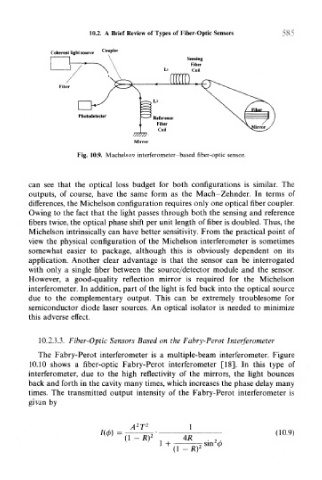Page 601 - Introduction to Information Optics
P. 601
10.2. A Brief Review of Types of Fiber-Optic Sensors 585
Coherent light source Cou P ler
Sensing
Fiber
Coil
Fig. 10.9. Machelson interferometer-based fiber-optic sensor.
can see that the optical loss budget for both configurations is similar. The
outputs, of course, have the same form as the Mach-Zehnder. In terms of
differences, the Michelson configuration requires only one optical fiber coupler.
Owing to the fact that the light passes through both the sensing and reference
fibers twice, the optical phase shift per unit length of fiber is doubled. Thus, the
Michelson intrinsically can have better sensitivity. From the practical point of
view the physical configuration of the Michelson interferometer is sometimes
somewhat easier to package, although this is obviously dependent on its
application. Another clear advantage is that the sensor can be interrogated
with only a single fiber between the source/detector module and the sensor.
However, a good-quality reflection mirror is required for the Michelson
interferometer. In addition, part of the light is fed back into the optical source
due to the complementary output. This can be extremely troublesome for
semiconductor diode laser sources. An optical isolator is needed to minimize
this adverse effect.
10.2.3.3. Fiber-Optic Sensors Based on the Fabry-Perot Interferometer
The Fabry-Perot interferometer is a multiple-beam interferometer. Figure
10.10 shows a fiber-optic Fabry-Perot interferometer [18]. In this type of
interferometer, due to the high reflectivity of the mirrors, the light bounces
back and forth in the cavity many times, which increases the phase delay many
times. The transmitted output intensity of the Fabry-Perot interferometer is
given by
2
A T
(1 - 1 + 4R (10.9)

